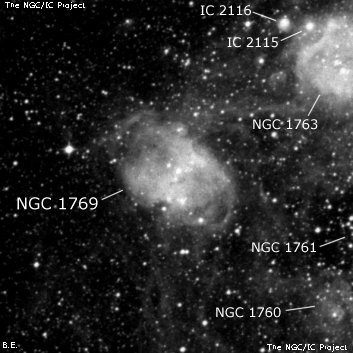
James Dunlop probably discovered NGC 1769 = D 232 on 6 Nov 1826 and reported "a faint round nebula, about 1 1/2' in diameter." His position is 11' SSW of the LMC nebula, but roughly matching the positional offset he made with NGC 1763.
John Herschel discovered the nebula on 2 Nov 1834 and recorded for h2716, "B, irregularly R; 2'; has a 10th mag star in centre." The next observation reads: "vB; vsmbM to a 10th mag star which is double or triple. Other clusters and nebulae in field." JH made a total of five observations of this nebula.
300/350mm - 13.1" (2/17/04 - Costa Rica): fairly bright HII region in a fascinating group with several clusters and nebulae. Appears fairly large, round, 2' diameter with a single mag 11 at the center. Situated 6' SE of the cluster/HII region NGC 1763 and a similar distance NNE of NGC 1760.
600/800mm - 30" (11/4/10 - Coonabarabran, 264x): bright, large oval nebula oriented SW-NE, roughly 3'x2'. At the center is a mag 11.5 "star" (Sk -66 41), with three mag 14-14.5 companions - the closest is 15" SE (Wo 599, an O3-class star). A small, bright knot (~10" diameter) is embedded on the south side of the nebula, just 0.9' S of the central star. NGC 1769 is roughly centered within the stunning NGC 1763 (Bean Nebula) complex with showpiece NGC 1763 just 6.5' NW, NGC 1761 6' WSW, NGC 1776 6' NE, NGC 1760 8' SW and NGC 1773 7' NNE.
Sk -66 41 was once thought to be one of the most single massive and luminous stars in the LMC but it was resolved into a very compact cluster with ~15 components. The star 15" southeast (Wo 599 = O3-class) may be the ionizing source of the nebula. The 10" knot on the south side (identified as HNT 1 in SIMBAD) has also been resolved into a compact cluster of ~70 stars mag 17 and fainter.
Notes by Steve Gottlieb